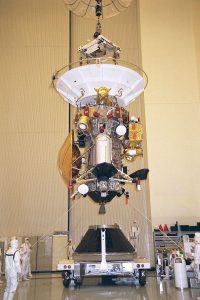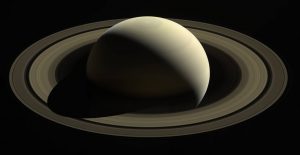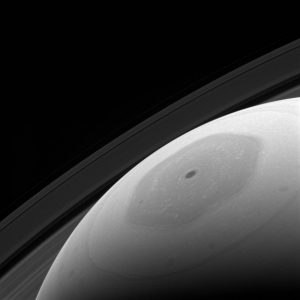Two days from now, on Friday the 15th of September 2017 the Cassini Spacecraft will make it’s final orbit around Saturn. After exploring Saturn and its moons for the past 13 years Cassini is now nearly out of fuel and NASA has decided to plunge the probe into the atmosphere of the ringed planet. The reason for ending the probe’s mission in this fiery fashion is to make certain that Cassini does not crash onto one of Saturn’s moons and possibly contaminate it with micro-organisms from Earth.
The Cassini-Huygens mission began almost 20 years ago on the 15th of October 1997 when the spacecraft was launched from Kennedy Space Center aboard a Titan IV-Centaur rocket. The probe’s long seven year journey to Saturn required gravity boosting flybys from Venus (twice), Earth and Jupiter in order to gain enough energy to reach the outer Solar System. The image below shows the Cassini-Huygens spacecraft prior to its launch.

Entering orbit around Saturn on the first of July 2004 Cassini released the Huygens landing module on the 25th of December 2004 and Huygens successfully landed on the Moon Titan on January the 14th, 2005. The lander, which was built by the European Space Agency, operated for 90 minutes sending back images and instrument measurements from the surface of the second largest moon in the Solar System. The first image below is a picture of the Huygens lander and the second is an image from the surface of Titan.


During it’s short operating life the Huygens lander found that the atmosphere of Titan was denser than Earth’s by about 45% with a composition of 95% nitrogen and 5% methane at a temperature of 98.3 degrees Kelvin (-179.3 Celsius). The rocks in the surface image above are actually water ice at a temperature so cold they are as hard as rocks!
The discoveries on Titan by Huygens were augmented by those of the Cassini orbiter which found both large lakes of liquid methane along with signs of channels other indications of erosion caused by flowing liquid methane. Between them Cassini and Huygens portray Titan as a world very similar to our own except it is so cold that methane has replaced water.
Since then the Cassini orbiter has continued its mission, making several major discoveries. One of the most important has been the eruptions of water ‘volcanoes’ spewing out of the moon Enceladus. The energy causing these eruptions is thought to be generated by the tidal forces of Saturn and its other moons and is similar to the process that heats Jupiter’s moons Io and Europa. After discovering the ‘volcanos’ the Cassini spacecraft was even sent into them in an attempt to analyze their composition. The plumes are indeed water but with a small amount of complex hydro-carbons mixed in. Are these complex molecules a sign of the beginning of life on Enceladus? Only time, and a lander to the moon will tell. The picture below is an artists idea of the hydro-thermal activity on Enceladus.

As far as I’m concerned however the best part of any mission to Saturn is simply the images of the planet and its system of rings. So without further ado I’ll just add a few below.



NASA has actually set up live internet coverage of Cassini’s final moments, although we can’t be quite certain exactly when that will happen. The show will start at 7AM Eastern Daylight Time on Friday the 15th and if you’d like to tune in, I will be, click on the link below to be taken to NASA’s Cassini End of Mission Activities website.
https://www.nasa.gov/press-release/nasa-announces-cassini-end-of-mission-media-activities
